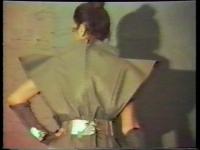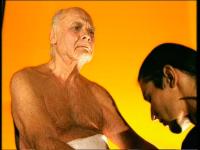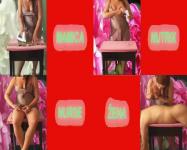Video Art from Conceptualism to Postmodernism
The Context
A long time has passed since video was labelled a new medium. Nevertheless, at least one generation must pass from the invention of a new (reproductive) technology, such as printmaking, photography and film, before it is accepted as a cultural tool and established as a means of artistic expression in its own right. This time lapse is even longer when it comes to interpretation, which should detect media-specific elements and place the new medium in the social and production framework. Video (magnetic tape), like all new image transmitters, preserves certain features possessed by previous technologies (e.g. cinema and photography) at the same time introducing new ones through technological innovation and different (content) encoding capabilities. Video technology changed film in the same way as the latest digital technology is changing video and film today. The term video is used nowadays for almost every moving image, with the sole exception of film.
Video art in Yugoslavia tracked the general ideological and aesthetic characteristics and usages of video technology, although – if we allow a certain generalisation despite the fact that the situation in each of the six constitutive republics of Yugoslavia was far from being the same – there were some specific features which at the same time also differentiated it from the international one. This fact cannot be easily perceived and understood without some basic information about the art and cultural situation in this former state (the Socialist Federative Republic of Yugoslavia) which managed to persevere for almost fifty years (1943-1991).
Several structural features defined the post-war political and cultural position of Yugoslavia: the country's size (with approximately 22 million inhabitants and an area of almost 100,000 square miles), its location (between the west and the east, the south and the north; Europe and Asia, Central Europe and the Balkans), as well as the peculiarities of its cultural and political history. The country’s political position between the Eastern (Warsaw Pact) and Western Bloc (NATO) generated a unique type of socialist system defined by "self-management" as a point which distinguished it both from communist regimes and democratic societies of liberal capitalism. It was yet another feature which enabled Yugoslavia to play an important role within global politics, i.e. its founding and decisive role in the Nonalignment movement which presented ‘the third option’.
The characteristics of the Yugoslav post-war art and cultural policy can be outlined only roughly for this occasion. Socialist Realism was officially renounced as early as in 1948 (after the split with the Inform-Bureau), losing its power even before it had really begun to function. Already as early as the 1950's there followed a period of the so-called ‘freedom of creation’ - based on Existentialism and Intimism - allowing artists to express themselves in a modernist language: i.e. Poetical/Magical Realism, Lyric Abstraction, Informel, Tachism, Abstract Expressionism etc. Those were also the years when the country was relatively open, i.e. travelling to the West was surprisingly easy and frequent - especially to Italy and Paris – thus resulting in the influence of the School of Paris and later, in the 1970's, of the New York School on Yugoslav artists.
Up to the end of the 1980's the country's art system was quite developed in comparison with other Eastern European countries: there was a considerable number of state and regional museums and galleries, numerous art and cultural magazines and a huge number of exhibitions and artists, while an art market with an appropriate system of management, sponsorship and private galleries etc., had not yet been established. Artists were neither awarded the title of 'the artist of merit’, which was the usual practice in Eastern European countries, nor were they able to participate in keen competition within the ‘free’ art market as in Western countries. Nevertheless, a free-lance status awarded to active artists by the Ministry of Culture was quite an exceptional attribute which provided Yugoslav artists with social security and a retirement plan.
Yugoslavia was, however, conservative with regard to the progressive and avant-garde movements. In fact, we can describe the history of Yugoslav art as a permanent discontinuous practice, one which has remained on the fringe and was never fully recognised (Impressionism, Constructivism, Conceptual Art, and the subculture and alternative art of the 1980's). The 1970's and 1980's, the years which are of the greatest interest to us here - the former marking the pioneering period of video art, and the latter somehow predicting the end of the Yugoslav cause - were characterized by strong opposition movements on the part of intellectuals as well as artists.
Video, as a reproductive technology which promised the democratisation and internationalisation of the media, played a similar role in the Yugoslav framework as that played by graphic art in the 1950's and 1960's. Thanks to graphic art in the post-war Yugoslav cultural milieu, links with international art and its manifestations were re-established, as well as international exhibitions of graphic art in numerous Yugoslav cities – notably the International Graphic Biennial in Ljubljana founded in 1955 – which presented to Yugoslav artists and the general public a series of key authors from around the world, from the Western and the Eastern bloc as well as from China, India and so-called Third World countries, thus contributing to an improved acquaintance with art events and trends in the world and at the same time slowly opening up the possibilities for cooperation and affirmation of Yugoslav artists on the international scene. In the 1960's, within the scope of contemporary visual art, graphic art was of great significance this also being the time when it presented a considerable part of the world graphic production which resulted in the well known Graphic School of Ljubljana.
The primary source of information and news remained Paris, with the characteristic rudimentarisation of visual speech into symbolic hieroglyphic signs of different sources and the predominant forms of quiet modernism, particularly those of lyric abstraction and Informel. It seems, however, that viewing graphic art through the graphic itself and all its working procedures – the so-called integral graphic art, when the author creatively implements the entire process, from conception to technical performance – was a characteristic which distinguished Yugoslav from West European graphic artists, who in most cases left the technical realization to printers. However, as early as the 1970's saw the attitude toward graphic art change, the objections mainly referring to its formalism and aestheticism, as well as to the unfulfilled promises of the democratisation of art and its accessibility to all. Despite the fact that, for example, graphic exhibitions in Yugoslavia were regularly organized in factories and companies – "in order to bring art to the workers" – even there this art discipline had preserved the bourgeois idealist interpretation of art, on the one hand as a reflection of reality and on the other as a utilizable object with a market value.
The Yugoslav policy of opening up toward other countries in the 1960's, after the aforementioned International Graphic Art Biennial exhibition which was held on a regular basis, also encouraged a series of important international shows in the field of culture, including the International Biennial of Industrial Design in Ljubljana, the Music Biennial, the Genre Film Festival and the New Tendencies exhibition in Zagreb, as well as the international film festival FEST and the international experimental theatre festival BITEF in Belgrade, which was open to various art disciplines and also had a visual arts program.
The idea of international art – which otherwise as a rule overlooks its class character and imperialist tendencies – suddenly, particularly as a result of the revolutionary events of 1968 (the Paris spring of 1968) throughout the United States and Europe, no longer seemed a utopia never to come true. The student unrest, joined by progressive intellectual men and women, also played the key role in Yugoslav circumstances. The revolutionary ideas cultivated during the 1960's and the 1970's in the West, which did not bypass even the Fortress of Art, were also familiar to younger Yugoslav artists. This representation persevered because they were able to identify with conceptual art, current at the time, above all in one main area: that of confronting those conservative institutions of art which maintained the academic hierarchy of artistic domains and the classical ways of expression and, as a consequence of that, discovering different, more independent channels of personal activity.
Around 1970 in addition to the so-called Centres of Liberty (= culture) and the Youth Cultural Centres, the Student Cultural Centres in the main Yugoslav cities (SKC in Belgrade, SKUC in Zagreb and ŠKUC in Ljubljana) also became the pivots of progressive ideas and transformations of art, while contacts with international events were gradually being established. The exhibitions, also international, which followed, generated intensive socialising and discussion, as well as the emergence of a sociocritical art practice. Through a series of actions and personal statements, the Yugoslav conceptual artists were also confronted with the issues of the position of art in society and the possibilities of acting upon it, significantly contributing to the shift in the understanding of art as a production of objects to the concept of artistic practice as a product of thought and memory.
A significant role was also played by video as a means of expression which placed the process of research and its effect on the public in the foreground. Perceived as a truly democratic medium available to anyone, in the beginning it also promised completely new artistic paradigms. When in 1977 one issue of the Zagreb photography review Spot was entirely dedicated to video, the authors attributed to this "medium of video recording" the exceptional role of generator of structural change in the ways of thinking, forms of behaviour and methods of seeing reality, while video works were seen as a great potential in the scope of social change, especially in the ideological confrontation with the domination of commerce and capital in the domain of artistic practice and promoting social solidarity, a dehierarchisation of values, the creativity of each individual and the overall availability of information and knowledge. Within this framework the review also published the so-called Graz Declaration (Grazer Deklaration, Pool-Video-Konferenz, Graz 1976) concerning the relationship between video and politics.
In the context of international space this enterprise was soon critically deemed a failure, because video had also joined the structure of the art system with all the characteristics and consequences which inevitably followed suit. The socializing role of video was supposed to be based on the altered relationship with the public, but one still had to attend the places dedicated to art in order to see video tapes. The potential danger that video too may fall into elitism turned out to be real; however, the question remains as to whether the cause was primarily the fact that the form of presentation and means of distribution did not manage (or want) to follow the production, or as to whether it was a trap – a danger or a wish – already intrinsic in the video production (art) itself.
Produkcija: SCCA-Ljubljana, 1998
Performance, Ritual and Memory je bil razstavni projekt, s katerim je SCCA-Ljubljana (Sorosov center za sodobno umetnost - Ljubljana) sodeloval pri mednarodnem umetniškem projektu Women Beyond Borders. V izboru Barbare Borčić so z deli sodelovale...
Produkcija: SCCA-Ljubljana, 1994
Tekst spremlja video program z naslovom "Od alternativne scene do avtorskega videa. Video produkcija v Slovenji 1992-1994, ki so ga v produkciji SCCA-Ljubljana in Galerije Škuc kurirale Zemira Alajbegović, Barbara Borčić in Eva Rohrman leta 1994....
Produkcija: Škuc - Forum, 1984
Avtorsko dokumentarni video o graffiti projektih skupine Irwin. S fotografijami, diasi, dokumentarnimi video posnetki in skozi razgovor z avtorji je prikazan proces dela, posamezni graffiti in njihovo funkcioniranje v določenem družbenem prostoru/ konte...
Produkcija: Škuc - Forum, 1984
Avtorsko-dokumentarni video o razstavnem projektu "Back to the USA" skupine R Irwin S (>Irwin), ki je bil realiziran v Galeriji Škuc aprila 1984. Projekt se je navezoval na eno najodmevnejših ameriških razstav z istim naslovom, ki je leta...



























